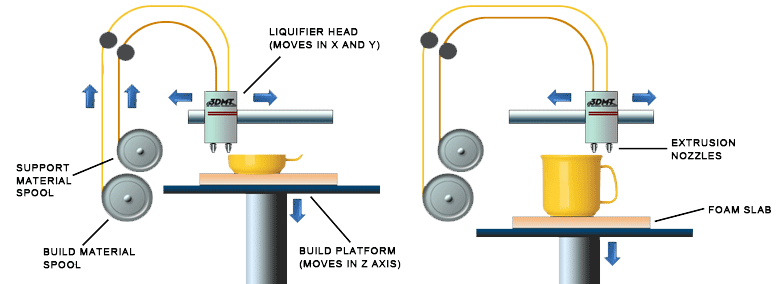Fused Deposition Modeling (FDM) is one of the methods used in 3D printers and is the preferred method for home 3D printers and generally the most common. FDM is a layer additive manufacturing process which uses thermoplastic materials (ABS, Polycarbonate, Ultem etc.) as the raw material or “ink” in the 3D printer. A thermoplastic material is one which becomes soft when heated and hard when cooled. This method is used for making prototypes in industry, by designers, educators, engineers and in home 3D printers among other uses. FDM was developed and invented by Scott Crump, the founder of Stratasys.
How Does FDM Work?
As with all 3D printing methods the process begins with the design being created as a CAD file. The data is transferred to the 3D printer where the data is interpreted. The chosen thermoplastic material is placed into the 3D printer. In a separate location a support material is entered into the 3D printer. This support material is necessary to hold the object, helping it to retain its form as it dries and grows on the build platform. The object is constructed layer by layer on the 3D printer’s build platform. The support material and thermoplastic material are delivered through drive wheels and into two syringe-like tubes and on through dual heated extrusion nozzles. As the two types of material are extruded they are heated by the nozzles. Precise layers of the thermoplastic and support material are squeezed out onto the build platform as the nozzles move across the platform in a horizontal X-Y plane. As each layer is completed the build platform moves down a fraction allowing room for the next layer to be exuded onto the preceding layer.
Once the part has been created it is taken from the build platform and the support material which has held the object in place as it was being formed is then removed. The object then has to be cleaned, sanded or polished. There are many finish options which can then be implemented to create smooth even surfaces.

Advantages and Disadvantages of FDM
FDM can be recycled as the thermoplastic material used can be reheated until they melt into their original form and can be reused. The thermoplastics are environmentally stable. FDM is clean and easy to use; it is suitable for those who have no technical knowledge of 3D printing. Creating intricate cavities and geometrical shapes is possible with FDM where as it would be difficult to achieve with other methods. The FDM method can accurately produce feature details and has an excellent strength-to-weight ratio. The FDM printer is also ideal for low-volume end-user parts. The resulting objects are durable and functional. The down side is that once the finished product is created it then needs to have the support material removed and cleaned or finished in some other way. However it is still the most prolific of the 3D printing techniques in use today in industry, in business and in the home.
3D-Print Today is an online news magazine bringing you up to date on all the latest news from the 3D Printing Industry. We work hard on finding interesting and unique news stories and fresh trends on the market.
Our online magazine provides a compelling blend of daily articles, fresh news, blog posts and opinions, as well as videos and visuals across all platforms through our main website, our mobile application and the social media network; all contains the detailed information and up to date news, for you to discover the amazing world of 3D Printing.
245 Greene Street
New York, NY 10012